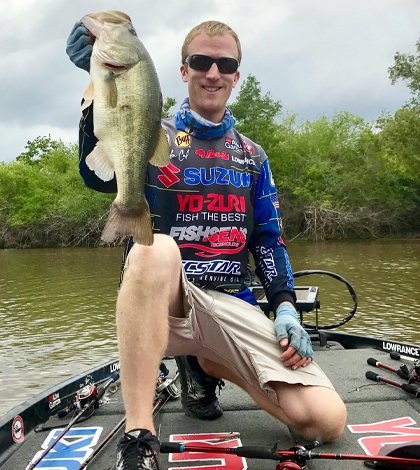Bottom Composition Matters, Underwater Cameras Can Help

Brandon Card uses a combination of onboard electronics and an underwater camera to inspect bottom composition and find the best fishing locations. (Courtesy of Brandon Card)
As a pro angler, I use my Lowrance electronics every single time I am on the water. They are great at locating fish and structure, but when combined with my FishSens SondeCAM HD Underwater Camera they can show everything. A camera is a great tool for someone who wants to better understand what they are seeing on their electronics and for me, it helps get a clear picture of one of the most important things in bass fishing: bottom composition.
Hard Spots
Hard bottoms are usually the best, and bass will relate to hard bottoms of different types depending on the region. My Lowrance StructureScan will show hard bottoms as bright, white areas on the screen where softer bottoms will be more grayish. This is helpful and what I look for as I am idling, but the SondeCam will let me know exactly what it is. It could be shell beds, clay, rocks or something different. Dropping the camera down after catching a fish will show me what the fish were holding to and then I can duplicate that across the lake and look for more areas with that same bottom composition.
The ideal bottom composition varies by region. Down south, in places like Florida and Alabama, it is all about finding a harder bottom when most of the lakes down there have a soft mucky bottom. It is really important around the spawn to find a hard bottom, but it makes a difference throughout the year. I use my camera to tell the difference because there may be a large area of softer bottom and then one hard spot like a rock, brush pile or something else and that is where the bass will be positioned.
On the Tennessee River chain of lakes, the bottom composition is vital when fishing offshore. I have found that shell beds, rock and clay are all important and bass will often use one or the other. Knowing which one they are using depends on the season and the lake. Rock is fairly easy to spot with electronics, but shell beds and clay are when the camera really helps.
Every lake on the TVA chain is different in what they like. On Douglas Lake, for instance, clay is usually the best. Finding the right bottom composition, whether rock, shell or clay is easy with a camera and then you can use it to look for similar areas in different parts of the lake if you are catching fish relating to clay bottoms.
Vegetation
Using my camera to take a closer look at grass is another thing that really helps me. It can be finding emergent vegetation or locating the type of grass that the bass are holding to that time of year.

Brandon Card lowers his SondeCAM underwater camera into some lake vegetation to check for bass. (Credit: FishSens Technology)
On some northern lakes, like Lake St. Clair in Michigan, there is a short grass often called “shrimp grass” that the perch, gobies and other baitfish like to hide in. It is what I look for when I go there and even though it comes up just six inches off the bottom, it is really the best thing to fish. Dropping my camera down allows me to find the grass but it also lets me take a look at the perch and gobies and I can match my lure color based on what I am seeing in that area.
During the spring when the grass is just starting to emerge, finding that new grass is a great pattern. It happens throughout the country as the grass starts to grow. I use my camera to find the new, crisp hydrilla in the spring. It is the same in the late fall or winter when the grass is starting to die and you are searching for the last remaining green grass.
Using my SondeCAM has made me better at reading and analyzing my Lowrance electronics. It helps to get a better picture of exactly what you are seeing on your screen and removes any doubt about what it is showing. Bottom composition matters and using the camera in conjunction with your electronics will help you find bass and then replicate those areas to catch more bass.
Top image: Bassmaster Elite Angler Brandon Card uses a his onboard electronics and underwater camera to inspect bottom composition and find the best fishing locations. (Courtesy of Brandon Card)




0 comments